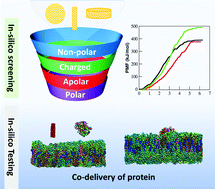Permeation of nanoparticles across the intestinal lipid membrane: dependence on shape and surface chemistry studied through molecular simulations†
Abstract
Nanoparticles are being explored for topical and oral drug delivery applications as they can cross various biological barriers, for example, the intestinal epithelium. The ability of nanoparticles to cross barriers depends on their morphological and surface properties such as size, surface chemistry and shape, among others. The effect of nanoparticle size on their membrane permeability has been well studied both experimentally and theoretically. However, less attention has been given to understand the role of nanoparticle shape in their translocation across biological barrier membranes. Here, we report on the influence of the nanoparticle's shape, surface chemistry and concentration on their permeation across a human intestinal apical cell membrane model. A representative multicomponent lipid bilayer model of the human intestinal apical membrane was built. The free energy of permeation of nanoparticles across the model lipid bilayer was calculated using multiple umbrella sampling simulations. The interaction of these nanoparticles with the model lipid bilayer was captured using extensive microsecond unrestrained molecular dynamics simulations. We observed that: (a) irrespective of the surface chemistry, the efficacy of nanoparticle penetration across the lipid layer was in the order of rod > disc > sphere; (b) irrespective of the shape, apolar and nonpolar nanoparticles were found to locate in the interior of the lipid bilayer, whereas charged and polar nanoparticles were either adsorbed on the lipid headgroups or remained in the water layer; (c) apolar and nonpolar disc shaped nanoparticles had higher efficacy in permeation across the lipid bilayer as compared to disc and sphere shaped nanoparticles; and (d) at a higher concentration of nanoparticles, sphere and disc shaped nanoparticles exhibited more agglomeration as compared to rod shaped nanoparticles. Based on these outcomes, a few nanoparticles were designed which penetrated readily into the lipid layer and these nanoparticles were also able to co-deliver a therapeutic protein inside the lipid layer. The apical model lipid membrane and protocols used in this study can thus be utilized for the in silico design of nanoparticles for the oral delivery of therapeutics.

- This article is part of the themed collection: Theoretical Modelling at Nano-bio Interfaces


 Please wait while we load your content...
Please wait while we load your content...